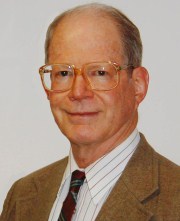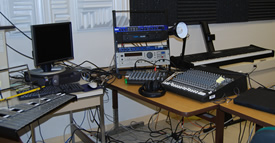
Robert C. Waag
Professor Emeritus of Electrical and Computer Engineering
Arthur Gould Yates Professor of Engineering
PhD, Cornell University, 1965
- Office Location
- 3-4309 Medical Center
- Telephone
- (585) 275-4430
Short Biography
Robert C. Waag received the BEE and MS degrees in electrical engineering, and the PhD degree in communications engineering, all from Cornell University, Ithaca, NY, in 1961, 1963, and 1965, respectively. He was a member of the technical staff at Sandia Laboratories, Albuquerque, NM, and then, served as an officer in the United States Air Force from 1966 to 1969 at the Rome Air Development Center, Griffiss Air Force Base, NY. In 1969, he joined the faculty of the University of Rochester, where he is currently an Arthur Gold Yates Professor in the Department of Electrical and Computer Engineering, School of Engineering and Applied Science, and also holds an appointment in the Department of Imaging Sciences, School of Medicine and Dentistry. His current research interests include ultrasonic scattering, propagation, and imaging in medical applications. Professor Waag received the Joseph H. Holmes Pioneer Award from the American Institute of Ultrasound in Medicine in 1992. He is a fellow of the Acoustical Society of America and the American Institute of Ultrasound in Medicine.
Research Overview
 The general objective of our work is the development of ultrasonic techniques that improve the utility of ultrasound as a diagnostic tool in medicine. To accomplish this objective, two major projects are underway. The first is the characterization of wavefront distortion and the development of adaptive compensation techniques. The second is development of high-resolution and quantitative imaging techniques. Other current technical goals are the determination of power spectra of tissue variations from the measurements of angular scattering and the correlation of the measured scattering data with the structure of tissue.
The general objective of our work is the development of ultrasonic techniques that improve the utility of ultrasound as a diagnostic tool in medicine. To accomplish this objective, two major projects are underway. The first is the characterization of wavefront distortion and the development of adaptive compensation techniques. The second is development of high-resolution and quantitative imaging techniques. Other current technical goals are the determination of power spectra of tissue variations from the measurements of angular scattering and the correlation of the measured scattering data with the structure of tissue.
Studies of Wavefront Distortion and Compensation
Studies of wavefront distortion will emphasize collection of wavefront distortion data from abdominal specimens, chest wall specimens, and other tissue normally found between the transducer and structures being imaged. Measurements will be made in a pulse-echo configuration with various f-number transmitters to examine the influence of effective scattering volume size on the estimation of time delay from scattering by a random medium. Measurements will also be made to determine the isoplanatic patch size, i.e., the size of the region over which a single set of corrections can be used effectively. Wavefront compensation techniques will be evaluated using measured data with new algorithms based on space-time processing methods developed in our laboratory as well as with new algorithms developed by others.
High-Resolution and Quantitative Imaging
Studies of focussing through aberrations will be accomplished using our special ring transducer system. Investigations of focussing through aberrations will also be accomplished using our special two-dimensional array transducer and associated electronics. Our focus correction methods are uniquely able to compensate for distortion in the shape of waveforms as well as in their arrival times. This involves calculations of predistorted waveforms that are then emitted by individual elements driven by programmable signal generators. Additionally, studies of image reconstruction techniques that do not employ the Born or Rytov approximation will be conducted. These studies will include analysis of a novel method in which eigenfunctions of the scattering operator are employed.
Research Interests
- Wavefront Distortion and Compensation
- High-Resolution and Quantitative Imaging
Publications
- "Measurement and correction of ultrasonic pulse distortion produced by the human breast," Hinkelman, L. M., Liu, D.-L., Waag, R. C., Zhu, Q., and Steinberg, B. D. J. Acoust. Soc. Am. 97(3):1958-69 (1995).
- "About the application of the Van Cittert-Zernicke theorem in ultrasonic imaging," Liu, D.-L. and Waag, R. C. IEEE Trans. Ultras. Ferro. and Freq. Contr. 42(4):590-601 (1995).
- "A comparison of wavefront distortion in one-dimensional and two-dimensional apertures," Liu, D.-L. and Waag, R. C. IEEE Trans. on Ultras. Ferro. and Freq. Contr. 42(4):726-733 (1995).
- "Wavespace resolution in ultrasonic scattering measurements," Mast, T. D., and Waag, R. C. J. Acoust. Soc. Am. 98(6):3050-3058 (1995).
- "Modified Gomori's trichrome stain for macroscopic tissue slices," Hinkelman, L. M., Metlay, L. A., Churukian, C. J., and Waag, R. C. J. Histotechnology. 19(4):321-323 (1996).
- "Propagation and backpropagation for ultrasonic wavefront design," Liu, D.-L., and Waag, R. C. IEEE Trans. on Ultras. Ferro. and Freq. Contr. 44(1):1-13 (1997).
- "Harmonic amplitude distribution in a wideband ultrasonic wavefront after propagation through human abdominal wall and breast specimens," Liu, D.-L., and Waag, R. C. J. Acoust. Soc. Am. 101(2):1172-1183 (1997).
- "Measurements of ultrasonic pulse distortion produced by the human chest wall," Hinkelman, L. M., Szabo, T. L., and Waag, R. C. J. Acoust. Soc. Am. 101(4):2365-2373 (1997).
- "Simulation of ultrasonic pulse propagation through abdominal wall," Mast, T. D., Hinkelman, L. M., Sparrow, V. W., Orr, M. J., and Waag, R. C. J. Acoust. Soc. Am. 102(2):1177-1191 (1997).
- "Focusing and imaging using eigenfunctions of the scattering operator," Mast, T. D., Nachman, A. I., and Waag, R. C. J. Acoust. Soc. Am. 102(2):715-725 (1997).
